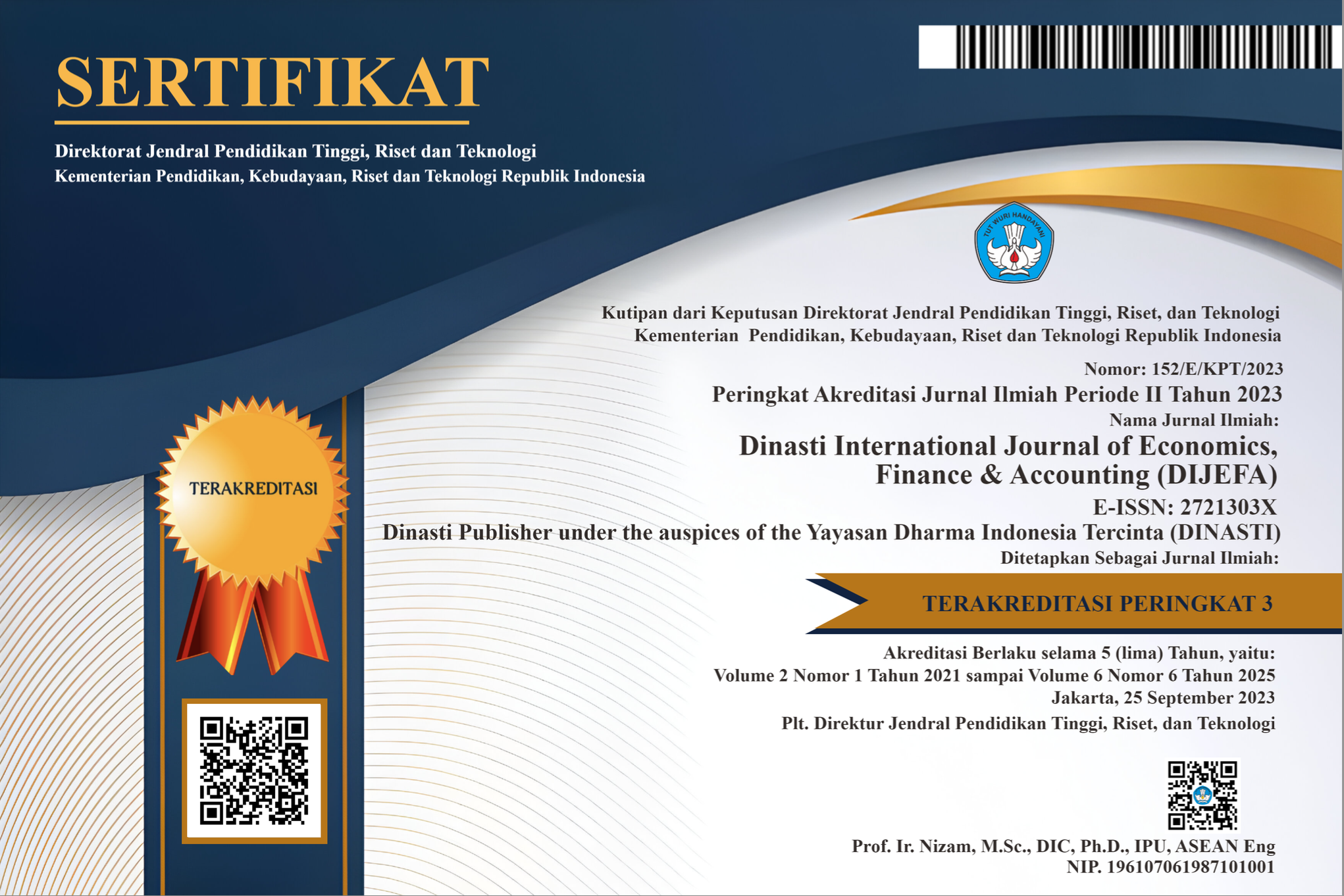The Impact of ESG Ratings on Stock Price and Volatility: Evidence from LQ45, FTSE KLCI, and FTSE STI
DOI:
https://doi.org/10.38035/dijefa.v6i2.4167Keywords:
Environmental, Social, and Governance (ESG) Score, Stock Returns, Stock Volatility, Panel Data RegressionAbstract
This study examines the impact of environmental, social, and governance (ESG) performance on stock returns and volatility in Southeast Asia, focusing on the LQ45 (Indonesia), FTSE KLCI (Malaysia), and FTSE STI (Singapore) indices from 2010 to 2022. Using composite ESG scores and individual E, S, and G scores, the research evaluates corporate sustainability performance and employs regression models to analyze their relationships with stock returns and volatility. The findings indicate that a higher combined ESG score is generally associated with lower stock returns and reduced volatility across the region. Among the individual ESG components, both environmental (E) and social (S) scores negatively impact stock returns, while the environmental (E) score also significantly reduces stock volatility. Governance (G) scores, however, show no significant effect on either returns or volatility. The study further explores how firm size and borrowing levels influence these relationships. For large firms, a higher ESG score boosts stock returns but lowers volatility. In contrast, smaller firms experience declines in both returns and volatility with increased ESG performance. When considering borrowing levels, firms with low debt benefit from higher ESG scores, which positively affect returns and modestly reduce volatility. Conversely, highly leveraged firms see decreased returns and increased volatility with higher ESG scores. These results underscore the nuanced relationship between ESG performance and financial outcomes in Southeast Asia, highlighting the importance of firm-specific characteristics. The study provides valuable insights for investors and corporate managers navigating the growing emphasis on sustainability in these emerging markets.
References
Alsahlawi, A. M., Chebbi, K., & Ammer, M. A. (2021). The Impact of Environmental Sustainability Disclosure on Stock Return of Saudi Listed Firms: The Moderating Role of Financial Constraints. International Journal of Financial Studies, 9(1), 4. https://doi.org/10.3390/ijfs9010004
Alsayegh, M. F., Abdul Rahman, R., & Homayoun, S. (2020). Corporate Economic, Environmental, and Social Sustainability Performance Transformation through ESG Disclosure. Sustainability, 12(9), 3910. https://doi.org/10.3390/su12093910
Andreas, Ioannis Oikonomou, Sautner, Z., Starks, L. T., & Zhou, X. (2023). ESG Shareholder Engagement and Downside Risk. Review of Finance, 28(2), 483–510. https://doi.org/10.1093/rof/rfad034
Asimakopoulos, P., Asimakopoulos, S., & Li, X. (2023). The role of environmental, social, and governance rating on corporate debt structure. Journal of Corporate Finance, 83, 102488–102488. https://doi.org/10.1016/j.jcorpfin.2023.102488
Aswani, J., Raghunandan, A., & Rajgopal, S. (2023). Are carbon emissions associated with stock returns? Review of Finance, 28(1). https://doi.org/10.1093/rof/rfad013
Avramov, D., Cheng, S., Lioui, A., & Tarelli, A. (2021). Sustainable Investing with ESG Rating Uncertainty. Journal of Financial Economics, 145(2), 642–664. https://doi.org/10.1016/j.jfineco.2021.09.009
Aydo?mu?, M., Gülay, G., & Ergun, K. (2022). Impact Of Esg Performance On Firm Value And Profitability. Borsa Istanbul Review, 22(2). https://doi.org/10.1016/j.bir.2022.11.006
Bain & Company, GenZero, Standard Chartered, & Temasek. (2024). Southeast Asia’s Green Economy 2024 Report. In Bain & Company. Bain & Company. https://www.bain.com/insights/southeast-asias-green-economy-2024/
Barko, T., Cremers, M., & Renneboog, L. (2021). Shareholder Engagement on Environmental, Social, and Governance Performance. Journal of Business Ethics, 180(180), 777–812. https://doi.org/10.1007/s10551-021-04850-z
Berg, F., Kolbel, J. F., & Rigobon, R. (2022). Aggregate Confusion: The Divergence of ESG Rating. Review of Finance, 26(6), 1315–1344. https://doi.org/10.1093/rof/rfac033
Bodie, Z., Kane, A., & Marcus, A. J. (2021). Investments (12th ed., pp. 58–60). Mcgraw-Hill Education.
Brealey, R. A., Myers, S. C., & Allen, F. (2020). Principles of corporate finance (13th ed., pp. 11–13). McGraw-Hill Education.
Burger, E., Grba, F., & Heidorn, T. (2022). The impact of ESG ratings on implied and historical volatility. Www.econstor.eu. https://hdl.handle.net/10419/251516
Campbell, J. Y., Lo, A. W., & Mackinlay, A. C. (1997). The econometrics of financial markets (pp. 10–11). Princeton University Press.
Clark, G. L., Feiner, A., & Viehs, M. (2015). From the Stockholder to the Stakeholder: How Sustainability Can Drive Financial Outperformance. SSRN Electronic Journal. https://doi.org/10.2139/ssrn.2508281
Deloitte. (2024). What is ESG? Deloitte. https://www2.deloitte.com/ce/en/pages/global-business-services/articles/esg-explained-1-what-is-esg.html
Engelhardt, N., Ekkenga, J., & Posch, P. (2021). ESG Ratings and Stock Performance during the COVID-19 Crisis. Sustainability, 13(13), 7133. https://doi.org/10.3390/su13137133
Environmental Resource Management . (2022). Costs and Benefits of Climate-Related Disclosure Activities by Corporate Issuers and Institutional Investors. In ERM Sustainibility Institute (pp. 5–6). ERM Sustainability Institute. https://www.erm.com/insights/costs-and-benefits-of-climate-related-disclosure-activities-by-corporate-issuers-and-institutional-investors/
Fadhillah, I., Nadiyah, Rohmah, L., Haryadi, D., Wahyudi, W., & Management, P. (2024). Profitability ratio analysis to assess the financial performance. IJAFIBS, 11(4), 964–969.
Fama, E. F. (1991). Efficient Capital Markets: II. The Journal of Finance, 46(5), 1575–1617. https://doi.org/10.2307/2328565
Fama, E. F., & French, K. R. (1992). The Cross-Section of Expected Stock Returns. The Journal of Finance, 47(2), 427–465. JSTOR. https://doi.org/10.2307/2329112
Freeman, R. E., Harrison, J. S., Wicks, A. C., Parmar, B. L., & de Colle, S. (2009). Stakeholder Theory. Stakeholder Theory the State of the Art, 83–100. https://doi.org/10.1017/cbo9780511815768
Friede, G., Busch, T., & Bassen, A. (2015). ESG and Financial performance: Aggregated Evidence from More than 2000 Empirical Studies. Journal of Sustainable Finance & Investment, 5(4), 210–233. https://doi.org/10.1080/20430795.2015.1118917
Fu, J. (2024). ESG, Stock Returns and Stock Volatility: Evidence from Chinese Listed Companies. SHS Web of Conferences, 181, 02002–02002. https://doi.org/10.1051/shsconf/202418102002
Gao, Y., Zhao, C., Sun, B., & Zhao, W. (2022). Effects of investor sentiment on stock volatility: new evidences from multi-source data in China’s green stock markets. Financial Innovation, 8(1). https://doi.org/10.1186/s40854-022-00381-2
Gavrilakis, N., & Floros, C. (2023). ESG performance, herding behavior and stock market returns: evidence from Europe. Operational Research, 23(1). https://doi.org/10.1007/s12351-023-00745-1
Gibson Brandon, R., Krueger, P., & Schmidt, P. S. (2021). ESG Rating Disagreement and Stock Returns. Financial Analysts Journal, 77(4), 104–127. https://doi.org/10.1080/0015198x.2021.1963186
Giese, G., Lee, L.-E., Melas, D., Nagy, Z., & Nishikawa, L. (2019). Foundations of ESG Investing: How ESG Affects Equity Valuation, Risk, and Performance. The Journal of Portfolio Management, 45(5), 69–83. https://doi.org/10.3905/jpm.2019.45.5.069
Grewal, J., Hauptmann, C., & Serafeim, G. (2020). Material Sustainability Information and Stock Price Informativeness. Journal of Business Ethics, 171, 513–544. https://doi.org/10.1007/s10551-020-04451-2
Gujarati, D. N., & Porter, D. C. (2009). Basic econometrics (5th ed., pp. 591–613). Mcgraw-Hill/Irwin.
He, G., Liu, Y., & Chen, F. (2023). Research on the Impact of Environment, Society, and Governance (ESG) on Firm Risk: An Explanation from a Financing Constraints Perspective. Finance Research Letters, 58, 104038–104038. https://doi.org/10.1016/j.frl.2023.104038
Henisz, W., Koller, T., & Nuttall, R. (2019). Five Ways that ESG Creates Value . In McKinsey & Company. McKinsey Quarterly. https://www.mckinsey.com/~/media/McKinsey/Business%20Functions/Strategy%20and%20Corporate%20Finance/Our%20Insights/Five%20ways%20that%20ESG%20creates%20value/Five-ways-that-ESG-creates-value.ashx
Hu, W., Shen, H., & Li, S. (2023). ESG performance and stock price fragility. Finance Research Letters, 56, 104101–104101. https://doi.org/10.1016/j.frl.2023.104101
Indonesia Stock Exchange. (2024). Stock Index. IDX. https://www.idx.co.id/en/products/index/
Kiesel, F., & Lücke, F. (2019). ESG in credit ratings and the impact on financial markets. Financial Markets, Institutions & Instruments, 28(3), 263–290. https://doi.org/10.1111/fmii.12114
Kurniawan, M., & Zaäfri Ananto Husodo. (2023). The effect of ESG performance on stock price volatility: A study of emerging markets in Asia. BISMA (Bisnis Dan Manajemen), 16(1), 28–46. https://doi.org/10.26740/bisma.v16n1.p28-46
Kutner, M. H., Nachtsheim, C. J., Neter, J., & Li, W. (2005). Applied linear statistical models (5th ed., pp. 406–410). Mcgraw-Hill Irwin. https://users.stat.ufl.edu/~winner/sta4211/ALSM_5Ed_Kutner.pdf
La Torre, M., Mango, F., Cafaro, A., & Leo, S. (2020). Does the ESG Index Affect Stock Return? Evidence from the Eurostoxx50. Sustainability, 12(16), 6387. https://doi.org/10.3390/su12166387
Liu, F., Umair, M., & Gao, J. (2023). Assessing oil price volatility co-movement with stock market volatility through quantile regression approach. Resources Policy, 81, 103375. https://doi.org/10.1016/j.resourpol.2023.103375
M?nescu, C. (2011). Stock returns in relation to environmental, social and governance performance: Mispricing or compensation for risk? Sustainable Development, 19(2), 95–118. https://doi.org/10.1002/sd.510
Mehta, P. D. (2015). Control Variables in Research. International Encyclopedia of the Social & Behavioral Sciences, 840–843. https://doi.org/10.1016/b978-0-08-097086-8.44013-4
Morningstar. (2021, May 13). ESG Disclosure and Performance in Southeast Asia. Sustainalytics.com. https://www.sustainalytics.com/esg-research/resource/investors-esg-blog/esg-disclosure-and-performance-in-southeast-asia
MSCI. (2023). ESG ratings & climate search tool. Www.msci.com. https://www.msci.com/our-solutions/esg-investing/esg-ratings-climate-search-tool
Pollman, E. (2022, October 31). The Making and Meaning of ESG. Papers.ssrn.com. https://ssrn.com/abstract=4219857
Porter, M. E., & Kramer, M. R. (2011). Creating Shared Value. Harvard Business Review, January-February 2011. https://hbr.org/2011/01/the-big-idea-creating-shared-value
Refinitiv. (2022). ENVIRONMENTAL, SOCIAL AND GOVERNANCE SCORES FROM REFINITIV. In Refinitiv. Refinitiv. https://www.lseg.com/content/dam/marketing/en_us/documents/methodology/refinitiv-esg-scores-methodology.pdf
Ross, S. A., Westerfield, R., Jaffe, J. F., & Jordan, B. D. (2022). Corporate finance (12th ed., pp. 6–8). New York Mcgraw-Hill Education.
State Street Global Advisors. (2022). Exploring the Link Between Stock Price Volatility and ESG Scores Shreyank Nishant Senior Quant Researcher. In SSGA. State Street Global Advisors. https://www.ssga.com/library-content/pdfs/ic/link-between-volatility-and-esg-scores.pdf
Statman, M., & Glushkov, D. (2009). The Wages of Social Responsibility. Financial Analysts Journal, 65(4), 33–46. https://www.jstor.org/stable/40390194
UN PRI. (2024). Linking ESG ratings to returns and volatility. PRI; UN PRI. https://www.unpri.org/listed-equity/linking-esg-ratings-to-returns-and-volatility/164.article
Yahoo Finance. (2024). Yahoo Finance - Business Finance, Stock Market, Quotes, News. Yahoo Finance. https://finance.yahoo.com/
Yin, X.-N., Li, J.-P., & Su, C.-W. (2023). How does ESG performance affect stock returns? Empirical evidence from listed companies in China. Heliyon, 9(5), e16320. https://doi.org/10.1016/j.heliyon.2023.e16320
Yunica, A. S., & Rokhim, R. (2023). Unveiling the hidden power: How ESG enhanced Indonesian companies’ financial flexibility. Jurnal Siasat Bisnis, 27(2), 171–187. https://doi.org/10.20885/jsb.vol27.iss2.art4
Zhou, D., & Zhou, R. (2021). ESG Performance and Stock Price Volatility in Public Health Crisis: Evidence from COVID-19 Pandemic. International Journal of Environmental Research and Public Health, 19(1), 202. https://doi.org/10.3390/ijerph19010202
&&&
Downloads
Published
How to Cite
Issue
Section
License
Copyright (c) 2025 Daffaliska Azaria Nugraha, Stylianos Asimakopoulos, Oktofa Yudha Sudrajat

This work is licensed under a Creative Commons Attribution 4.0 International License.
Authors who publish their manuscripts in this journal agree to the following conditions:
- The copyright on each article belongs to the author(s).
- The author acknowledges that the Dinasti International Journal of Economics, Finance & Accounting (DIJEFA) has the right to be the first to publish with a Creative Commons Attribution 4.0 International license (Attribution 4.0 International (CC BY 4.0).
- Authors can submit articles separately, arrange for the non-exclusive distribution of manuscripts that have been published in this journal into other versions (e.g., sent to the author's institutional repository, publication into books, etc.), by acknowledging that the manuscript has been published for the first time in the Dinasti International Journal of Economics, Finance & Accounting (DIJEFA).


























































